David M. Byrne
Well-Known Member
Hello once again!
It’s almost 7 years since I was last in Mongolia, a country that conjures up visions of the untamed - Chinggis Khaan, camels wandering the Gobi Desert and wild horses galloping across the steppes. The huge, landlocked country, the 17th largest in the world, is a bit remote so not too many people venture up there. Most of those who visit do so - & just as I did - as a stop-off on the Trans-Mongolian Railway en route to/from China or Russia. I had very fond memories of my first visit to the country back in February of 2006 so I was looking forward to getting back, something I did for week 35, days 239 through 245, of my on-going travel odyssey. This, as always, is a pictorial recap of my time in Mongolia as presented to the RPF community.
Picture 182, Day 240 – The Mongolian grasslands from the Hohhot to Ulan Bator train. October 31st 2012
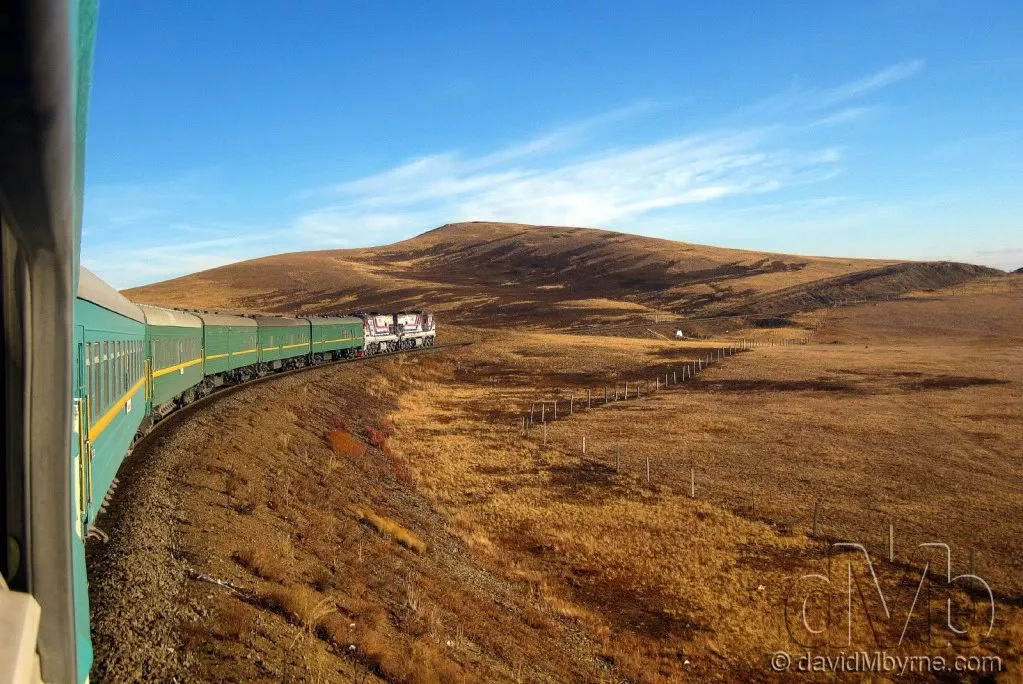
Leaving China for Mongolia, which I did on day 239 of the trip, marked the start of at least 3 weeks of long train trips, trips that would eventually take me through some 8 time zones as I made my way home to Ireland for Christmas. The above picture is the first of many train or railway related pictures I’ll be posting over the coming few entries. It was taken from my carriage window, 36 hours into the Hohhot, China, to Ulan Bator, the Mongolia capital & my destination. I could just about get my hand out the small opening in the window (but only after taking my watch off) so this was taken with my small point-and-shoot; getting an SLR out the opening wasn't an option. I captured an almost identical picture to this some 7 years ago when I first did this trip, although back then it was February and there was snow on the ground. While this isn't the Gobi desert (it dominates the southern third of the country whereas this is near Ulan Bator further north) it is some of the grassland that makes up 52% of the Mongolian landmass. Used mainly for grazing, this land of emptiness with no fences (except when skirting the rail line) or privately owned land is a boy scout's dream.
Picture 183, Day 241 – Migjid Janraisig Sum, Ulan Bator, Mongolia. November 1st 2012
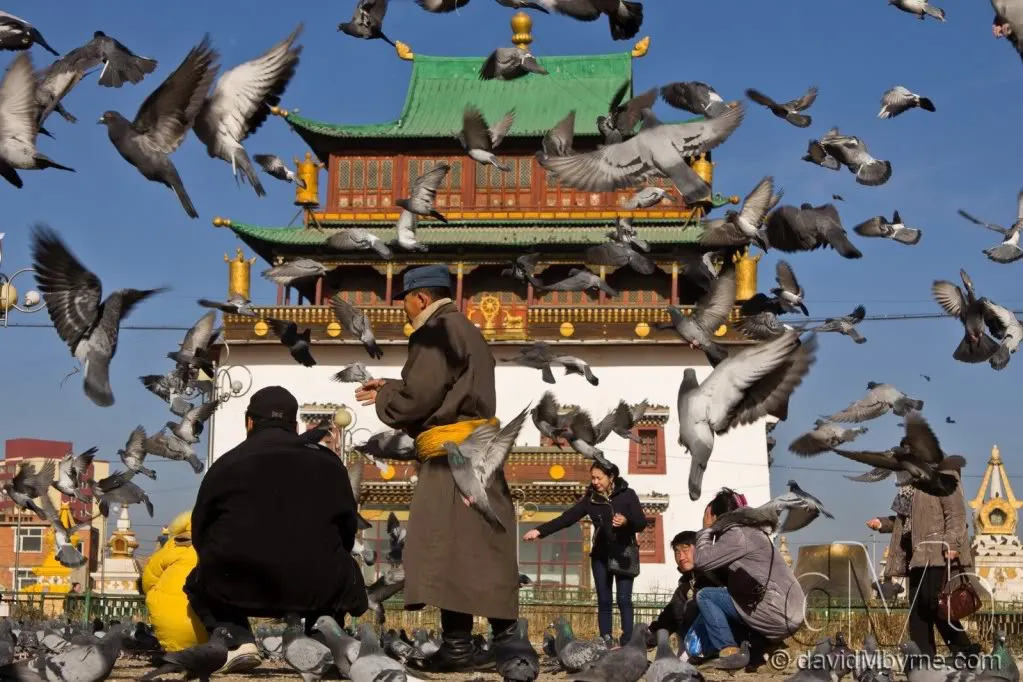
Ulan Bator is the Mongolian capital & easily its biggest city – it’s the all-encompassing centre of the Mongolian universe. It has the look and feel of a neglected 1950's European city & even now, over 20 years after the fall of the Soviet Union, the city is still dominated by communist style high-rise apartment buildings & old Soviet cars and buses still ply the streets. There’s an unkempt, sometimes sleepy feel to the place that goes hand in hand with an unrushed laid-backness. Admittedly there’s not a lot, if any, stand-out sights here. The above picture was captured in front of Migjid Janraisig Sum, easily Ulan Bator’s most impressive & thus most famous building. Hundreds, maybe thousands, of pigeons congregate in the square fronting the temple waiting to be fed. A nervous disposition ensures they take flight en masse as a result of any sudden movement, providing a very photogenic scene. I hung around here for a while & was guilty of provoking the pigeons on more than one occasion in a bid to get this picture. Needs must.
Picture 184, Day 241 – Ulan Bator, Mongolia, from Elephants Head. November 1st 2012
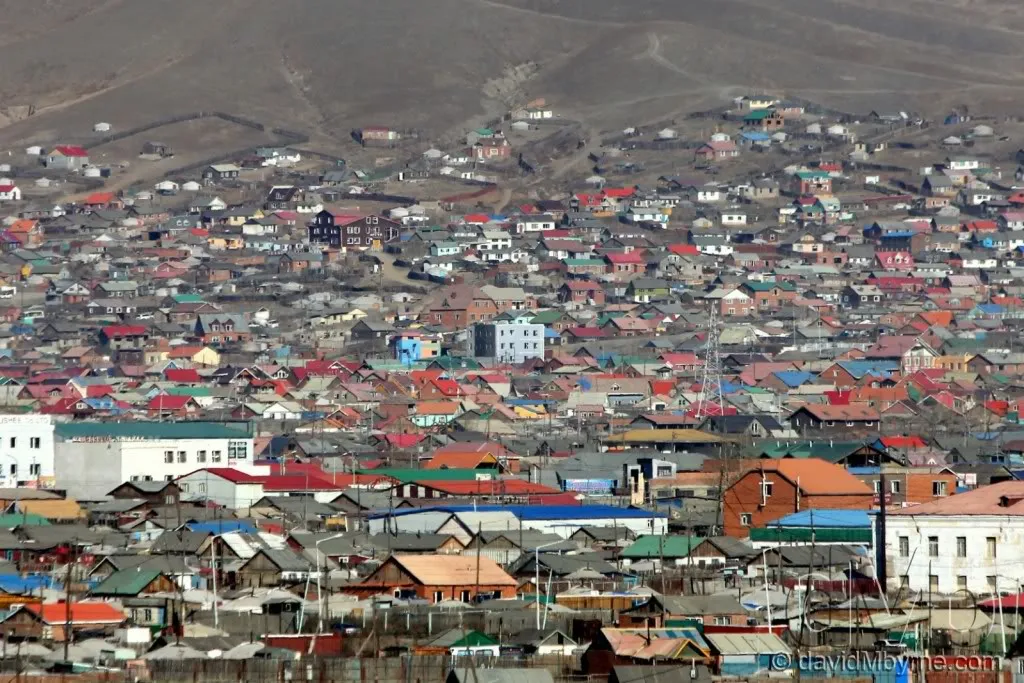
This is a picture taken from Zaany Tolgoi, or Elephant's head, a hill overlooking Ulan Bator. I ventured up here to be reacquainted with the view of Ulan Bator’s outskirts, a sight that’s none too appealing – even from here the ramshackle condition of the outer city suburbs is apparent.
Picture 185, Day 243 – Walking in Terelj National Park, Mongolia. November 3rd 2012
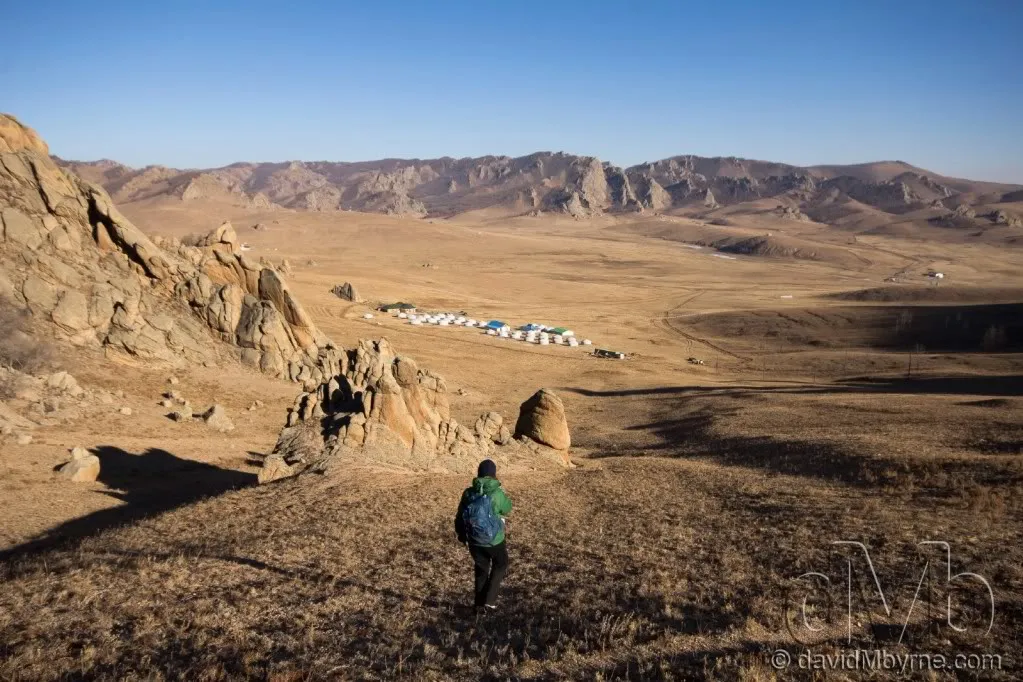
I'm almost ashamed to admit that on my previous visit to Mongolia in early 2006 I failed to get out into the countryside - the -40 degree Celsius temperatures common in February had a lot to do with that. By arriving this time in late October I was straddling the end of the high/tourist & start of the low/winter season so the temperatures were much more bearable. Still cold, but bearable. Anyway, I was determined to get out amongst all that Mongolian nothingness & the Terelj National Park, a couple of hours bumpy bus ride outside of Ulan Bator, provided that. It – the park – is more touristy then authentic, more hilly than flat, but it still offers the most convenient escape from the city & has enough open space to satisfy most. This is a picture of my girlfriend & travel partner, Mel, approaching our ger camp in the distance (see picture 186 below) after a we-don`t-want-to-get-lost-out-here ramble in the Terelj National Park.
Picture 186, Day 243 – Turtle Rock, Terelj National Park, Mongolia. November 3rd 2012
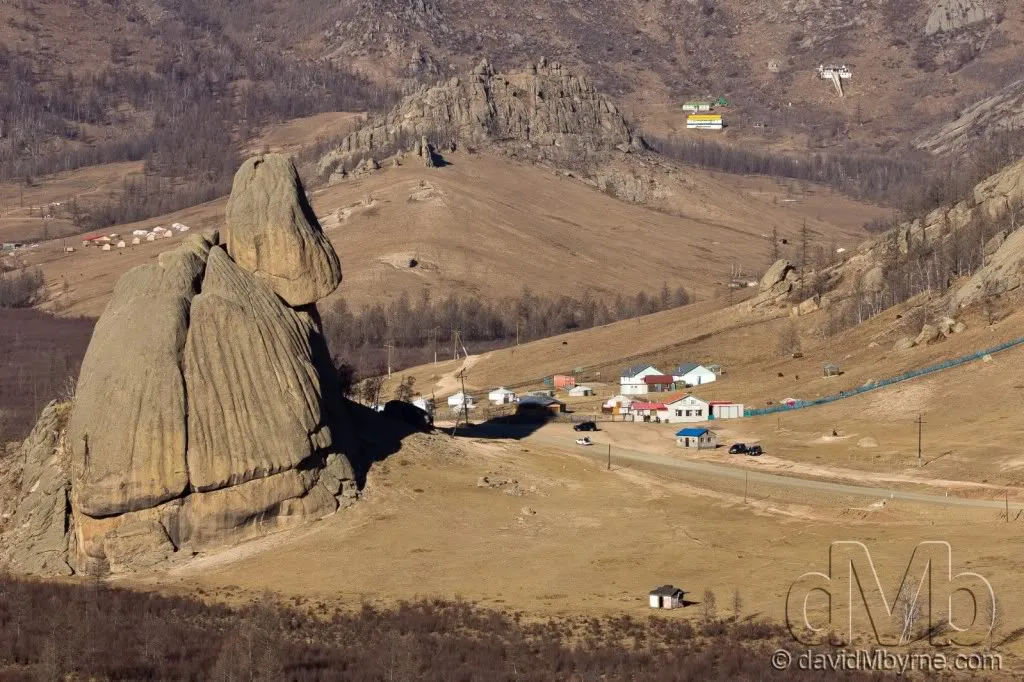
The park is home to a few well-known rock formations including this, appropriately called Turtle Rock. I took this picture having walked down the valley after paying a visit to a Buddhist temple (small white building, top right of frame). It was quite the hike.
Picture 187, Day 243 – Ger, Terelj National Park, Mongolia. November 3rd 2012
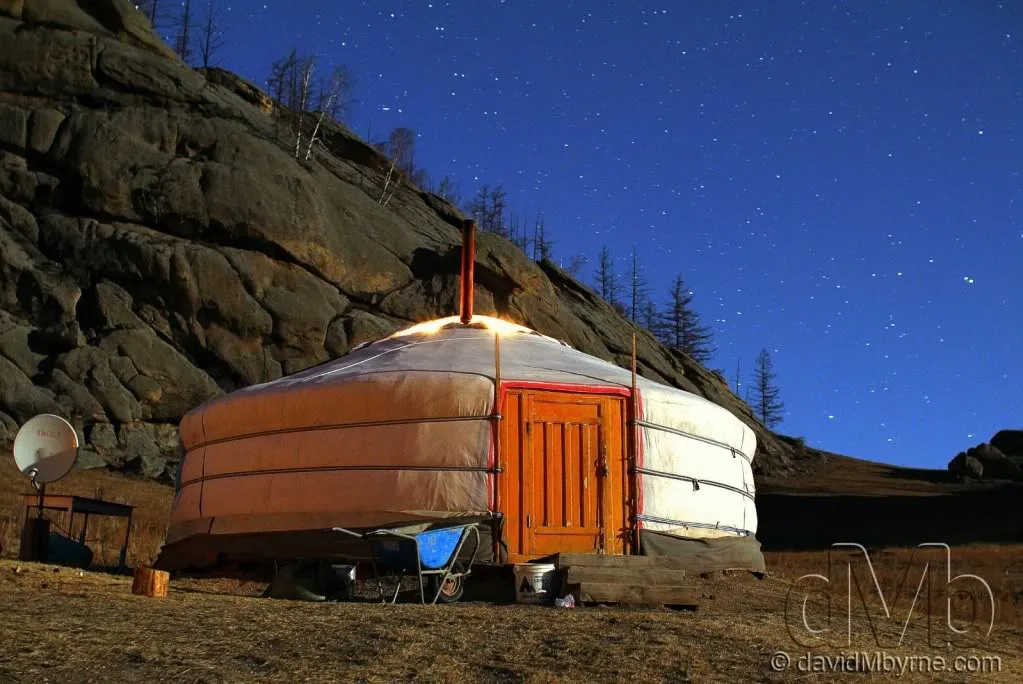
A small portion at the southern end of Terelj National Park is developed for tourists, meaning it offers accommodation in tourist ger camps. While a far cry from an authentic Mongolian ger experience, spending a night or two in a one of these is still the highlight of a visit to Mongolia for many (it was for me). It also provided me with this picture, my photographic highlight of this visit to Mongolia.
A ger is a traditional circular tent with an outer & inner layer of (usually) canvas & an insulated layer of felt sandwiched in between (more layers in winter, fewer in summer). It's all supported by a collapsible wooden frame, meaning the ger can, if needed and depending on size, be assembled in 1 to 3 hours, perfect for Mongolia's 390,000 thousand nomadic herdsmen who, while tending to some 30 million livestock, need to be flexible and mobile so they can move their settlement in search of better grazing. No lack it here in the Guru Tourist Park but in the absence of electricity candles or lamps provide lighting and there is normally a stove in the centre used for cooking and heating. Toilets are always outdoors and if showers exist at all they'd be found in a bathhouse serving a ger settlement or community. Unchanged in centuries, gers are still the preferred housing for most Mongolians, even in the suburbs of the cities. Needless to say out here in the countryside it's all you'll see.
I spent two nights in one of these gers and thankfully it was as warm and the glow emanating from the top of this one (although we didn't have satellite!). The above picture, a 30-second exposure, is the result of two nights attempting this shot. It was captured in sub-zero temperatures & almost black darkness - the only available light was that escaping from the apex of the ger, which I used as a manual focus point for the shot. Numerous shots were taken to first get the exposure right & then the orientation (which still isn't quite there) - this was on a hill and with no tripod I found myself using an oil can to support the camera & a few lens caps, sticks & stones to straighten up the shot.
The dMb Photography Blog: Terelj National Park, Mongolia
Picture 188, Day 244 – Sükhbaatar Square, Ulan Bator, Mongolia. November 4th 2012

It was back to Ulan Bator for one last visit before departing for Russia, which I'll begin to cover in the next entry. I have already mentioned how the city is short on notable sights. This isn't something that really bothered me all that much because for me Ulan Bator was/is all about its people - it’s a great place for street or people photography with subjects running the gamut from elderly traditionally dressed Mongolians to the smartly dressed nouveaux riche. This is a picture I captured of a man dressed in traditional Mongolian del descending the steps in front of the enormous Chinggis Khaan statue in Sükhbaatar Square, the main square in the centre of the city. The square I named after Damdiny Sükhbaatar, the 'hero of the revolution' who, in July 1921, used the square to declare Mongolia's independence from the Chinese. It – the square - is the primary people-watching location in town & I spent a bit of time here on most days capturing people coming and going. The massive statue of Chinggis Khaan, history’s best known Mongolian, lording over his nation is the newest addition to the square. It was unveiled in 2006, only weeks after my last visit, to mark the 800-year anniversary of the Great Khaan’s coronation.
What/Where Is Next?
Russia & the continuation of the long train trips. For the next two weeks the entries will be a recap of my 2 week adventure crossing Siberian Russia on the Trans-Mongolian railway. I was on a crusade to do that trip justice with a camera so check in with entries for weeks 36 & 37 to see how I got on.
dMb Travel
Don’t forget, & as I always say, you can keep right up to date with all aspects of my trip, including my present whereabouts, from-the-road updates, tweets & archived links to all previous RealPhotographersForum Mave on the Move entries, by visiting the dedicated travel page of my photography blog, a page I set up to specifically chronicle this trip.
Until next time.
David M
It’s almost 7 years since I was last in Mongolia, a country that conjures up visions of the untamed - Chinggis Khaan, camels wandering the Gobi Desert and wild horses galloping across the steppes. The huge, landlocked country, the 17th largest in the world, is a bit remote so not too many people venture up there. Most of those who visit do so - & just as I did - as a stop-off on the Trans-Mongolian Railway en route to/from China or Russia. I had very fond memories of my first visit to the country back in February of 2006 so I was looking forward to getting back, something I did for week 35, days 239 through 245, of my on-going travel odyssey. This, as always, is a pictorial recap of my time in Mongolia as presented to the RPF community.
Picture 182, Day 240 – The Mongolian grasslands from the Hohhot to Ulan Bator train. October 31st 2012

Leaving China for Mongolia, which I did on day 239 of the trip, marked the start of at least 3 weeks of long train trips, trips that would eventually take me through some 8 time zones as I made my way home to Ireland for Christmas. The above picture is the first of many train or railway related pictures I’ll be posting over the coming few entries. It was taken from my carriage window, 36 hours into the Hohhot, China, to Ulan Bator, the Mongolia capital & my destination. I could just about get my hand out the small opening in the window (but only after taking my watch off) so this was taken with my small point-and-shoot; getting an SLR out the opening wasn't an option. I captured an almost identical picture to this some 7 years ago when I first did this trip, although back then it was February and there was snow on the ground. While this isn't the Gobi desert (it dominates the southern third of the country whereas this is near Ulan Bator further north) it is some of the grassland that makes up 52% of the Mongolian landmass. Used mainly for grazing, this land of emptiness with no fences (except when skirting the rail line) or privately owned land is a boy scout's dream.
Picture 183, Day 241 – Migjid Janraisig Sum, Ulan Bator, Mongolia. November 1st 2012

Ulan Bator is the Mongolian capital & easily its biggest city – it’s the all-encompassing centre of the Mongolian universe. It has the look and feel of a neglected 1950's European city & even now, over 20 years after the fall of the Soviet Union, the city is still dominated by communist style high-rise apartment buildings & old Soviet cars and buses still ply the streets. There’s an unkempt, sometimes sleepy feel to the place that goes hand in hand with an unrushed laid-backness. Admittedly there’s not a lot, if any, stand-out sights here. The above picture was captured in front of Migjid Janraisig Sum, easily Ulan Bator’s most impressive & thus most famous building. Hundreds, maybe thousands, of pigeons congregate in the square fronting the temple waiting to be fed. A nervous disposition ensures they take flight en masse as a result of any sudden movement, providing a very photogenic scene. I hung around here for a while & was guilty of provoking the pigeons on more than one occasion in a bid to get this picture. Needs must.
Picture 184, Day 241 – Ulan Bator, Mongolia, from Elephants Head. November 1st 2012

This is a picture taken from Zaany Tolgoi, or Elephant's head, a hill overlooking Ulan Bator. I ventured up here to be reacquainted with the view of Ulan Bator’s outskirts, a sight that’s none too appealing – even from here the ramshackle condition of the outer city suburbs is apparent.
Picture 185, Day 243 – Walking in Terelj National Park, Mongolia. November 3rd 2012

I'm almost ashamed to admit that on my previous visit to Mongolia in early 2006 I failed to get out into the countryside - the -40 degree Celsius temperatures common in February had a lot to do with that. By arriving this time in late October I was straddling the end of the high/tourist & start of the low/winter season so the temperatures were much more bearable. Still cold, but bearable. Anyway, I was determined to get out amongst all that Mongolian nothingness & the Terelj National Park, a couple of hours bumpy bus ride outside of Ulan Bator, provided that. It – the park – is more touristy then authentic, more hilly than flat, but it still offers the most convenient escape from the city & has enough open space to satisfy most. This is a picture of my girlfriend & travel partner, Mel, approaching our ger camp in the distance (see picture 186 below) after a we-don`t-want-to-get-lost-out-here ramble in the Terelj National Park.
Picture 186, Day 243 – Turtle Rock, Terelj National Park, Mongolia. November 3rd 2012

The park is home to a few well-known rock formations including this, appropriately called Turtle Rock. I took this picture having walked down the valley after paying a visit to a Buddhist temple (small white building, top right of frame). It was quite the hike.
Picture 187, Day 243 – Ger, Terelj National Park, Mongolia. November 3rd 2012

A small portion at the southern end of Terelj National Park is developed for tourists, meaning it offers accommodation in tourist ger camps. While a far cry from an authentic Mongolian ger experience, spending a night or two in a one of these is still the highlight of a visit to Mongolia for many (it was for me). It also provided me with this picture, my photographic highlight of this visit to Mongolia.
A ger is a traditional circular tent with an outer & inner layer of (usually) canvas & an insulated layer of felt sandwiched in between (more layers in winter, fewer in summer). It's all supported by a collapsible wooden frame, meaning the ger can, if needed and depending on size, be assembled in 1 to 3 hours, perfect for Mongolia's 390,000 thousand nomadic herdsmen who, while tending to some 30 million livestock, need to be flexible and mobile so they can move their settlement in search of better grazing. No lack it here in the Guru Tourist Park but in the absence of electricity candles or lamps provide lighting and there is normally a stove in the centre used for cooking and heating. Toilets are always outdoors and if showers exist at all they'd be found in a bathhouse serving a ger settlement or community. Unchanged in centuries, gers are still the preferred housing for most Mongolians, even in the suburbs of the cities. Needless to say out here in the countryside it's all you'll see.
I spent two nights in one of these gers and thankfully it was as warm and the glow emanating from the top of this one (although we didn't have satellite!). The above picture, a 30-second exposure, is the result of two nights attempting this shot. It was captured in sub-zero temperatures & almost black darkness - the only available light was that escaping from the apex of the ger, which I used as a manual focus point for the shot. Numerous shots were taken to first get the exposure right & then the orientation (which still isn't quite there) - this was on a hill and with no tripod I found myself using an oil can to support the camera & a few lens caps, sticks & stones to straighten up the shot.
The dMb Photography Blog: Terelj National Park, Mongolia
Picture 188, Day 244 – Sükhbaatar Square, Ulan Bator, Mongolia. November 4th 2012

It was back to Ulan Bator for one last visit before departing for Russia, which I'll begin to cover in the next entry. I have already mentioned how the city is short on notable sights. This isn't something that really bothered me all that much because for me Ulan Bator was/is all about its people - it’s a great place for street or people photography with subjects running the gamut from elderly traditionally dressed Mongolians to the smartly dressed nouveaux riche. This is a picture I captured of a man dressed in traditional Mongolian del descending the steps in front of the enormous Chinggis Khaan statue in Sükhbaatar Square, the main square in the centre of the city. The square I named after Damdiny Sükhbaatar, the 'hero of the revolution' who, in July 1921, used the square to declare Mongolia's independence from the Chinese. It – the square - is the primary people-watching location in town & I spent a bit of time here on most days capturing people coming and going. The massive statue of Chinggis Khaan, history’s best known Mongolian, lording over his nation is the newest addition to the square. It was unveiled in 2006, only weeks after my last visit, to mark the 800-year anniversary of the Great Khaan’s coronation.
What/Where Is Next?
Russia & the continuation of the long train trips. For the next two weeks the entries will be a recap of my 2 week adventure crossing Siberian Russia on the Trans-Mongolian railway. I was on a crusade to do that trip justice with a camera so check in with entries for weeks 36 & 37 to see how I got on.
dMb Travel
Don’t forget, & as I always say, you can keep right up to date with all aspects of my trip, including my present whereabouts, from-the-road updates, tweets & archived links to all previous RealPhotographersForum Mave on the Move entries, by visiting the dedicated travel page of my photography blog, a page I set up to specifically chronicle this trip.
Until next time.
David M
